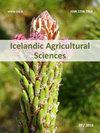Genetic parameters for lamb carcass traits assessed by video image analysis, EUROP classification and in vivo measurements.
IF 0.2
4区 农林科学
Q4 AGRICULTURE, MULTIDISCIPLINARY
引用次数: 12
Abstract
The heritability of yield predictions obtained from video image analysis (VIAscan®) of lamb carcasses (n=18,680) and EUROP classes obtained by abattoir assessors (n=26,795) was estimated, as well as the genetic and phenotypic correlations between VIAscan® traits and in vivo lamb traits (n = 9,930), including ultrasonic measurements, visual conformation score and length of the cannon bone. The main objective of the study was to test the equivalence of EUROP classes obtained by VIAscan® and visual scoring as selection criteria in the breeding work. Genetic correlations between EUROP scores from VIAscan® and from abattoir assessors were 0.94 for conformation and 0.82 for fat score. The heritability of conformation score was 0.32 and 0.35 based on VIAscan® and visual scoring, and 0.29 and 0.31 for the fat score, respectively. Yield predictions as proportions of lean meat of carcass weight from VIAscan® were highly heritable, h 2 ranging from 0.39 to 0.63. Lean meat yield (LMY) estimated as lean weight in major cuts had a direct heritability ranging from 0.17 to 0.21, maternal heritability ranging from 0.09 to 0.11 and a common environmental (c 2 ) effect of 0.22-0.23. Lean meat yield of the whole carcass (LMY_%) had the highest genetic correlation to visual leg score (0.44) while correlations between lean yield of three carcass parts (LegY_%, LoinY_% and ShoulderY_%) and in vivo measurements were low to moderately high and favourable except for loin yield. The EUROP scores obtained by both methods had similar genetic and phenotypic correlations to in vivo traits where conformation scores were highly correlated to visual scores for legs and shoulders and ultrasonic muscle measurements and fat scores were positively correlated to ultrasonic fat measurements and shoulder scores. It is concluded that VIAscan® can be used as a grading tool for the Icelandic sheep industry and measurements of carcass traits obtained from the system would be useful in the national sheep breeding program.通过视频图像分析、EUROP分类和体内测量对羔羊胴体性状的遗传参数进行了评价。
通过视频图像分析(VIAscan®)对羔羊胴体(n=18,680)和屠宰场评估人员(n=26,795)获得的EUROP分类进行产量预测的遗传力估计,以及VIAscan®性状与体内羔羊性状(n= 9,930)之间的遗传和表型相关性,包括超声测量、视觉构象评分和羊骨长度。本研究的主要目的是检验VIAscan®获得的EUROP等级和视觉评分在育种工作中作为选择标准的等效性。来自VIAscan®的EUROP评分与屠宰场评估者的遗传相关性为构象0.94,脂肪评分0.82。根据VIAscan®和视觉评分,构象评分的遗传力分别为0.32和0.35,脂肪评分的遗传力分别为0.29和0.31。以VIAscan®瘦肉占胴体重的比例预测产量具有高度遗传性,h 2范围为0.39 ~ 0.63。瘦肉产量(LMY)的直接遗传力为0.17 ~ 0.21,母系遗传力为0.09 ~ 0.11,环境(2c)效应为0.22 ~ 0.23。全胴体瘦肉产量(LMY_%)与视觉腿部评分的遗传相关性最高(0.44),胴体3个部位(腿_%、腰_%和肩_%)的瘦肉产量与体内测量的相关性均为低至中高,除腰_%外均较好。两种方法获得的EUROP评分与体内性状具有相似的遗传和表型相关性,其中构象评分与腿部和肩部的视觉评分高度相关,超声波肌肉测量和脂肪评分与超声波脂肪测量和肩部评分正相关。综上所述,VIAscan®可以作为冰岛绵羊产业的分级工具,并且通过该系统获得的胴体性状测量将在国家绵羊育种计划中有用。
本文章由计算机程序翻译,如有差异,请以英文原文为准。
求助全文
约1分钟内获得全文
求助全文
来源期刊

Icelandic Agricultural Sciences
AGRICULTURE, MULTIDISCIPLINARY-
CiteScore
0.80
自引率
0.00%
发文量
0
审稿时长
>12 weeks
期刊介绍:
Icelandic Agricultural Sciences is published annually, or more frequently. The deadline for submitting manuscripts that are intended to appear within that year is September. The journal is in English and is refereed and distributed internationally. It publishes original articles and reviews written by researchers throughout the world on any aspect of applied life sciences that are relevant under boreal, alpine, arctic or subarctic conditions. Relevant subjects include e.g. any kind of environmental research, farming, breeding and diseases of plants and animals, hunting and fisheries, food science, forestry, soil conservation, ecology of managed and natural ecosystems, geothermal ecology, etc.
 求助内容:
求助内容: 应助结果提醒方式:
应助结果提醒方式:


